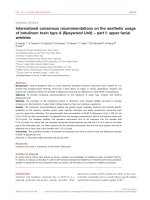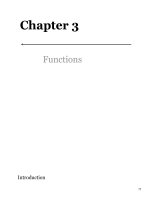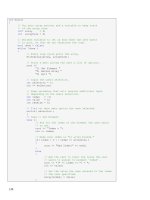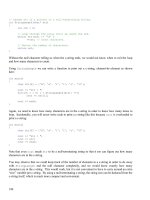Ebook Essentials for the canadian medical licensing exam - Review and prep for MCCQE part I: Phần 2
Bạn đang xem bản rút gọn của tài liệu. Xem và tải ngay bản đầy đủ của tài liệu tại đây (24.63 MB, 436 trang )
CHAPTER
11
Hematology
Surabhi Rawal, Dr. Sapna Rawal, and Dr. Ahmed Galal
SPLENOMEGALY
RATIONALE
CLINICAL BOX
Major Causes of
Splenomegaly
Splenomegaly is usually suggestive of an underlying disorder, rather than a 1◦ splenic
pathology. Therefore, Rx is aimed at the underlying etiology.
CAUSAL CONDITIONS
ICE MASS:
Infectious
Congestive splenomegaly/
Chronic liver disease
Extramedullar hematopoiesis
Malignancy
Table 11.1 Causal Conditions of Splenomegaly
Demand for ↑
splenic
function
Clearance of
abnormal RBCs
•
•
•
•
•
•
•
•
•
•
•
•
•
•
Abnormalities of RBC shape (hereditary spherocytosis/elliptocytosis)
Hemoglobinopathies (thalassemias)
Nutritional anemias
Acute (infectious mononucleosis, hepatitis, SBE)
Chronic (TB, AIDS, malaria, brucellosis, syphilis)
Bacterial septicemia
Splenic abscess
RA (Felty syndrome)
SLE
Collagen vascular diseases
Drug reactions
Myelofibrosis
Marrow toxicity (chemotherapeutic agents, radiotherapy)
Marrow infiltration (solid tumors, leukemia, storage diseases)
Altered splenic circulation
•
•
•
•
Cirrhosis
Portal vein obstruction
Splenic vein obstruction
CHF
Splenic infiltration
•
•
•
•
•
Storage diseases (Niemann-Pick, Gaucher, nonlipoid)
Amyloidosis
Malignancy (leukemias, lymphomas, metastases)
Splenic cysts
Myeloproliferative disorders
Infection
Amyloidosis
Sarcoidosis, Storage disease
Autoimmune
Extramedullary
hematopoiesis
289
290
Essentials for the Canadian Medical Licensing Exam: Review and Prep for MCCQE Part I
APPROACH
See Figure 11.1.
CLINICAL BOX
Hypersplenism
• Cytopenia 2◦ to splenomegaly of most
etiologies
• Key features are splenomegaly, hyperplastic
bone marrow, modest pancytopenia
• Occasional RBC spherocytosis, typically
reticulocytosis
• Treat underlying disease
• Avoid splenectomy when possible to
avoid risk of OPSI
• If necessary administer vaccines versus Strep
pneumo, HiB, N. meningitidis, and annual
influenza vaccine and prophylactic Abx Tx
CLINICAL BOX
Dx of Splenomegaly on Exam
Castell method: If the spleen is normal, percussion in the lowest intercostal space (eighth to ninth) in the
left anterior axillary line of the supine patient elicits a resonant note throughout the respiratory cycle. If
percussion on full inspiration produces a dull note (Castell sign), this is suggestive of splenic enlargement.
BLEEDING TENDENCY/BRUISING
RATIONALE
Bleeding that is spontaneous or excessive/delayed in relation to the inciting trauma must
be examined for underlying pathology.
APPLIED SCIENTIFIC CAUSES
See Figure 11.2.
CAUSAL CONDITIONS
The clinical history should consider likely etiologies:
1. Personal history of bleeding diathesis
2. Family history of bleeding diathesis
3. Medication use
291
Figure 11.1 Approach to splenomegaly.
292
Essentials for the Canadian Medical Licensing Exam: Review and Prep for MCCQE Part I
Figure 11.2 Coagulation cascade.
CLINICAL BOX
C2 L E O B o x
Reporting Child Abuse
Medications that Affect Coagulability
Children with extensive bruises
may represent child abuse and
there may be a requirement for
reporting.
1. Affect platelet function: FANTAStic Queen
• Folate antagonists
• ASA
• NSAIDs
• Thiazide diuretics
• Alcohol abuse
• Sulfa/β-lactam Abx
• Quinidine
2. Affect coagulation pathway: Abx that affect gut flora and induce Vit K deficiency
Table 11.2 Causal Conditions of Bruising and Bleeding
Coagulation Disorders
(2◦ Hemostasis)
Purpuric Disorders (1◦ Hemostasis)
Platelet Plug Formation
Quantitative Defects
↓ Production
↑ Destruction
Splenomegaly
Qualitative
Defects
• Nonimmune
• ↓ Megakaryopoe• ↑ Sequestration • Inherited (von Wille(TTP/HUS,
sis (aplastic anemia,
brand, Bernard
DIC, infection)
toxic, displacement)
Soulier, Glanzmann
• Ineffective megakar- • Immune (ITP,
• Acquired (uremia,
SLE, quinidine)
yopoesis (B12 /folate
ASA, NSAIDs,
deficiency, folate
antiplatelet agents)
antagonist)
Vascular
Response
Fibrin Clot
• Congenital (collagen • Inherited (factor
disease, herediVIII, IX deficiency)
tary hemorrhagic
• Acquired (liver
telangiectasia)
disease, Vit K
deficiency, antico• Acquired (vasculitis, steroids)
agulants, inhibitors)
• Fibrinolysis (DIC,
inhibitors)
Chapter 11 • Hematology
293
C2 L E O B o x
Prenatal Dx and Counseling
• Counseling on prenatal Dx of sickle cell disease and thalassemia should be nondirective and not
restricted to those willing to have an abortion.
• Reproductive decisions must not be forced by the results of tests.
• Because the only pragmatic options for mothers are abortion or no children, it is vital that women not be
pressured into prenatal Dx.
APPROACH
Figure 11.3 Approach to bleeding and bruising.
CLINICAL BOX
Tests for Hemostasis
1◦
• Platelet count
• Platelet function test
2◦
• PTT—intrinsic pathway factors (VII, IX, XI, XII), monitor heparin Rx
• PT-INR —extrinsic pathway factor (VII), monitor warfarin Rx
• IT —measures fibrinogen deficiency or ↓ prothrombin activation
294
Essentials for the Canadian Medical Licensing Exam: Review and Prep for MCCQE Part I
CLINICAL BOX
C2 L E O B o x
PTT 1:1 Dilution
Blood Transfusion Refusal
If PTT corrects with 1:1 dilution =
absolute deficiency in factor level
In patients who are bleeding but refuse blood transfusion, it must be determined whether the decision can
be justified within the context of a relatively stable set of values. If a coherent and consistent justification
does not exist, identify a substitute decision maker.
If PTT remains high = factor
inhibitor present
HYPERCOAGULABLE STATE
DEFINITION
• Hypercoagulable conditions may be inherited or acquired, and can pose the risks of
potential venous thrombosis and PE.
• Thrombophilia refers to the congenital deficiency of a normal protein such that there is
an ↑ risk of thrombotic events.
CAUSAL CONDITIONS
Table 11.3 Causal Condition for Hypercoagulable State
Inherited
Thrombophilia
(<50-yr old)
Acquired
disorders /risk
factors
Cellular elements
(hypercoagulability)
•
•
•
•
•
•
•
•
•
•
•
Vascular endothelium
•
(injury)
•
Circulatory (hemostasis) •
•
•
•
Antithrombin deficiency
Protein C, S deficiency
Factor V Leiden (APC resistance)
Prothrombin 20210 mutation
Hyperhomocysteinemia
Malignancy
Pregnancy, OTC, HRT, tamoxifen
Hyperhomocysteinemia
Hyperviscosity (Waldenstr¨om, multiple myeloma, PCV)
HIT
Other (antiphospholipid Ab syndrome, nephrotic syndrome)
Surgery, trauma
Hyperhomocysteinemia
Surgery, trauma
Pregnancy
Immobilization
CHF, atrial fibrillation
CLINICAL BOX
HIT with Subsequent
Thrombosis
• Patient has Ab against the
PF4 –heparin complex.
• Leads to ↓ in platelet count
(<150,000/mm3 or <50%
of baseline) and a 30-fold ↑
in risk of thrombosis.
• Discontinue heparin —cannot
replace with LMWH (crossreactivity), warfarin (skin
necrosis), ASA, or IVC filter.
• Instead, switch to either
direct thrombin inhibitors or
heparinoid anticoagulation.
APPROACH
CLINICAL BOX
Clinical Screening Tests for Thrombosis
1. Initial tests
• Inherited defects: APC resistance (factor V Leiden), prothrombin 20210 mutation, factor VIII level
• Acquired defects/risk factors: antiphospholipid Ab (lupus anticoagulant, anticardiolipin Ab)
2. Postrecovery testing
• Inherited defects: antithrombin activity, protein C activity, protein S activity, free and total levels
(varies with levels of C4 binding protein)
• Cannot be performed during acute event because levels fluctuate with active thrombosis and are
suppressed by warfarin Rx.
Chapter 11 • Hematology
Figure 11.4 Approach to hypercoagulability states.
295
296
Essentials for the Canadian Medical Licensing Exam: Review and Prep for MCCQE Part I
CLINICAL BOX
Diagnostic Testing
1. 1◦
•
•
•
2. 2◦
•
•
•
Tests
Compression U/S: gold standard in veins above the calf
Pulmonary angiography: gold standard for PR
Spiral CT: becoming more commonly used in suspected CT but cannot be used in patients with
compromised renal function
Tests
Contrast venography: if U/S not feasible/informative but difficult for patient
MRI: accurate as venography but expensive, used for patients with pregnancy, poor renal function, or
contrast agent allergy
V/Q scan: routinely used in suspected PE
ANEMIA
DEFINITION
• Anemic processes reduce the number of circulating erythrocytes, either through ↓
production or ↑ destruction.
• Anemias are usually classified according to MCV, which is an assessment of RBC
size.
• In any of the three categories (microcytic, macrocytic, and normocytic), 1◦ etiologies
can involve bone marrow and erythrocyte abnormalities, immunologic disorders, and
nutritional deficits; chronic and inflammatory diseases can induce the condition secondarily.
APPLIED SCIENTIFIC CONCEPTS
Table 11.4 Megaloblastic Anemia—Caused by Vitamin B12
or Folate Deficiency
CLINICAL BOX
Principal Causes of
Microcytic Anemia:
TAILS
• Thalassemia
• Anemia of chronic disease/inflammation
• Iron-deficiency anemia
• Lead toxicity-associated
anemia
• Sideroblastic anemia
Causes of Folate Deficiency
Causes of Vitamin B12 Deficiency
• Dietary insufficiency
• Impaired absorption (inflammation/
resection)
• Systemic causes:
• ↑ Consumption due to pregnancy
• Certain medications
• Certain medical conditions
(i.e., psoriasis)
• Absorption depends on secretion of intrinsic factor
by gastric parietal cells; if Vit B12 compound taken
up in terminal ileum
• Impaired parietal cell function (gastrectomy, pernicious anemia —autoimmune destruction of parietal
cell mass
• Disease of distal ileum (Crohn ileitis, tapeworm,
lymphoma)
CAUSAL CONDITIONS
Table 11.5 Causal Conditions of Anemia
Microcytic (<80 fL)
Normocytic (80–100 fL)
Macrocytic (>100 fL)
• Thalassemias
• Anemia of chronic disease/inflammation
• Iron deficiency
• Lead toxicity-associated
anemia
• Sideroblastic anemia
• EPO deficiency (renal insufficiency,
anti-EPO Ab)
• Bone marrow aplasia/hypoplasia
(1◦ , 2◦ from drugs, toxins, infections, radiation)
• Myelofibrosis
• Myelophthisis
• Megaloblastic (Vit B12 , folate
deficiency)
• Nonmegaloblastic
(drugs —chemotherapeutic,
immunosuppressive)
Chapter 11 • Hematology
APPROACH
Figure 11.5 Approach to anemia.
297
298
Essentials for the Canadian Medical Licensing Exam: Review and Prep for MCCQE Part I
Figure 11.5 (Continued ).
CLINICAL BOX
Drugs that can induce megaloblastic anemia (depress/affect metabolism of Vit B12 or folate): PAM ASA
MOM
•
•
•
•
•
•
•
Pyrimidine analogs (5-FU, zidovudine)
Anticonvulsants (phenytoin, phenobarbital, primidone)
6-Mercaptopurine and other purine analogs (acyclovir)
ASA
Methotrexate
Oral contraceptives
Metformin
CLINICAL BOX
Confirm Baseline Levels of B12
Do not administer folic acid without confirming Vit B12 levels; normalized folate will resolve the anemia
and mask Vit B12 deficiency, allowing hemopathy to progress.
POLYCYTHEMIA VERA/ELEVATED HEMOGLOBIN
RATIONALE
• Elevated hemoglobin levels (>185 g/L [men], >165 g/L [women]) can be attributed to:
• PCV, a myeloproliferative disorder with clonal expansion of erythroid, myelocytic,
and megakaryocytic lineages
• Erythrocytosis, 2◦ to underlying systemic processes
Chapter 11 • Hematology
299
APPLIED SCIENTIFIC CONCEPTS
• Hemoglobin and hematocrit measure the ratio of RBC mass to plasma volume; therefore,
they are sensitive to changes in either one.
• Determination of polycythemia must be based on direct assessment of RBC mass and
plasma volume. ‘‘True’’ polycythemia involves an absolute ↑ of RBC mass, whereas
‘‘relative’’ polycythemia (Gaisbo¨ ck) is a ↓ in volume.
• Erythropoiesis begins with a pluripotent hematopoietic stem cell and follows a hierarchic
process of lineage commitment and differentiation.
CAUSAL CONDITIONS
Table 11.6 Causal Conditions of PCV
True Polycythemia
Appropriate ↑ EPO
(2◦ Erythrocytosis)
• Hypoxemia (living at high
altitude, COPD, congenital cardiac anomalies)
• Hemoglobinopathies (with
an ↑ affinity for O2 )
Inappropriate ↑ EPO
Relative Polycythemia
• PCV
• Renal pathology (renal artery stenosis)
• Malignancy (renal cell, hepatocellular, ovarian, uterine tumors)
• Cerebral hemangioma
• ↑ Carboxyhemoglobin (chronic smoking, exposure to carbon monoxide)
• ↓ Plasma volume
(burns, diarrhea)
• Stress (Gaisb¨ock)
CLINICAL BOX
Characteristics of PCV
60 Jewish men HATE BIG Spleens
•
•
•
•
•
60 (median age of Dx)
Jewish men (slight predominance)
Headache (2◦ to ↓ cerebral circulation)
Abdominal discomfort
Tired (↑ risk of TIA)
•
•
•
•
•
↓ Exercise tolerance and ↑ Epistaxis
Blurred vision and ↑ Blood viscosity
Itchy (pruritus 2◦ to histamine release)
Gouty arthritis and GI bleeding
BIG Spleens (splenomegaly)
CLINICAL BOX
Criteria for PCV
Requires three major criteria or first two major and any two minor criteria.
ASC Box
EPO
Stimulation: ↓ in oxygenation of
blood
Production: peritubular kidney
cells
Action: bone marrow, ↑ RBC production
Major
1. ↑ RBC mass (≥36 mL/kg [♂], ≥32 mL/kg [♀])
2. Normal SaO2 (≥92%)
3. Splenomegaly
Minor
1. ↑ Platelets (>400,000/μL)
2. ↑ WBC (>12,000/μL)
3. ↑ Leukocyte alkaline
phosphatase
4. ↑ Vit B12
300
Essentials for the Canadian Medical Licensing Exam: Review and Prep for MCCQE Part I
APPROACH
Figure 11.6 Approach to PCV.
LYMPHADENOPATHY
DEFINITION
• The normal immune response promotes lymph node enlargement, through the proliferation of its cellular elements.
• Except for the inguinal nodes, diameters >1 cm are considered abnormal.
Chapter 11 • Hematology
301
• The location of the enlarged node is helpful in localizing the site of foreign antigen
invasion; generalized lymphadenopathy suggests systemic involvement.
ADVANCED SCIENTIFIC CONCEPTS
• Lymphatic system consists of lymph nodes and vessels as well as the thymus, spleen,
and Peyer patches in the gut.
For a simplified schematic of immune system, see Figure 15.10.
Figure 11.7 Anatomy of a normal lymph node. (Image from Rubin E, Farber JL. Pathology , 3rd ed. Philadelphia: Lippincott Williams & Wilkins;
1999.)
CAUSAL CONDITIONS
CLINICAL BOX
Most Common Etiologies of Lymphadenopathy
U MIND?
• Unexplained
• Metastatic carcinoma/sarcoma
• Immune system malignancies (leukemia, lymphoma) and Inflammatory conditions (collage diseases, vasculitides, amyloidosis, sarcoidosis)
• Neoplasms (all other tumors)
• Drainage of local infection or Disseminated infection
302
Essentials for the Canadian Medical Licensing Exam: Review and Prep for MCCQE Part I
Table 11.7 Causal Conditions of Lymphadenopathy
Endo
• Thyroid pathology (inflammation, hyperthyroidism)
• Adrenal insufficiency
Infectious
•
•
•
•
Viral (EBV, CMV, hepatitis, HIV)
Bacterial (pyogenic bacteria, syphilis, TB)
Fungal (histoplasmosis)
Parasitic (toxoplasmosis)
Immune/inflammation
•
•
•
•
•
Collagen diseases (RA, SLE, Kawasaki, Sj¨ogren)
Serum sickness
Drug reactions (phenytoin, allopurinol)
Sarcoidosis
Amyloidosis
Hematologic
malignancy
• Leukemia (AML/CML, ALL/CLL)
• Lymphoma (non–Hodgkin)
• Hemoglobinopathies (Waldenstr¨om, multiple myeloma)
Other malignancy
• Breast/lung carcinoma
• Kaposi sarcoma
• Head/neck CA
Storage diseases
• Gaucher, Niemann-Pick
APPROACH
See Figure 11.8.
FEVER IN THE IMMUNE COMPROMISED HOST/RECURRENT FEVER
DEFINITION
Compromised immunity ↑ susceptibility to infection. The etiology and severity of immunosuppression predispose to certain types of causative organism and particular sites.
CLINICAL BOX
Typical Infectious
Organisms in CMI
Defects versus
Asplenia/
Hypogammaglobinemia
CMI defects: predispose to infection with intracellular pathogens
• Bacteria (L. monocytogenes,
Salmonella spp., Legionella
spp., and mycobacterial
spp.)
• Fungal (C. neoformans, Candida spp., P. jirovecii/carinii)
• Parasitic (T. gondii)
• Viral (varicella-zoster, HSV,
CMV)
Hypogammaglobinemia and
asplenia predispose to infection with encapsulated bacteria:
Strep pneumo, H. influenza,
N. meningitidis
APPLIED SCIENTIFIC CONCEPTS
• Thermoregulation is centrally regulated in the preoptic area of the hypothalamus, which
stimulates various heat-retention and dissipation responses to maintain a thermal set
point.
• Pyrogenic cytokines released by mononuclear phagocytes have the capacity to raise
this set point.
• RES includes the spleen, lymph nodes, liver, marrow, and lung in its tissue component
and macrophages and monocytes in its cellular component.
• Spleen has two components:
• White pulp produces lymphocytes.
• Red pulp filters blood and contains phagocytes that ingest/phagocytose circulating
microorganisms and eliminates senescent RBCs.
CAUSAL CONDITIONS
ASC Box
Complement and Immune Dysfunction
Normally involved in inducing inflammation, leukocytosis; protective against viruses, improves bacterial
opsonization, produces bacterial cell wall/membrane lysis.
Inherited complement deficiencies:predispose to frequent and recurrent infections with encapsulated
bacteria
Acquired complement deficiencies: can develop with rheumatologic disorders (SLE)
303
Figure 11.8 Approach to lymphadenopathy.
304
Essentials for the Canadian Medical Licensing Exam: Review and Prep for MCCQE Part I
Table 11.8 Causal Conditions of Fever in the Immunocompromised Host
Hematologic
factors of
host defense
CMI
Circulating
proteins
Splenic
function
Extrahematologic
• Lymphocytes
A. Acquired CMI defects (1◦ —HIV/AIDS, 2◦ —Hodgkin, immunosuppressive Rx, lymphocytic
leukemia)
B. Inherited CMI defect
C. Natural killer cell deficiency
• Phagocytes
A. Phagocytosis (1◦ /acquired)
B. Neutropenia
• Immunoglobulins
A. Loss
B. ↓ Production
• Complement deficiencies
• Hyposplenism/functional asplenia (hemoglobinopathy [sickle cell disease], congenital)
• Therapeutic splenectomy (splenic injury/trauma, malignancy, thrombocytopenia, hemolytic anemia)
• Anatomic barriers are abnormal
A. Surgery
B. Foreign bodies
C. Burns
D. Desquamating rash
APPROACH
Figure 11.9 Approach to fever in the immunocompromised host.
Chapter 11 • Hematology
305
Table 11.9 Classical Findings in Neutropenic Patients
and Their Associated Pathogens
Physical Exam
Oral mucositis
Black eschar
Necrotizing skin lesions
Subcutaneous nodules (nontender)
Skin papules (nontender)
RLQ abdominal tenderness (+/−
pan, distention, bloody diarrhea)
Perineal tenderness
Inflammation/pain at IV, catheter
site
Viridans streptococci, HSV, Candida spp.
Aspergillus, mucor
P. aeruginosa, aspergillus
Nocardia, cryptococcus
Candida
Typhlitis (neutropenic enterocolitis) 2◦ to
pseudomonas, E. coli, Clostridium spp.
Gram-negative bacilli, anaerobes
Coagulase negative staph, corynebacterium,
Bacillus spp.
Humoral Immunity
Chest radiography
Localized infiltrate
Nodular infiltrate
Cavitary lesions
Diffuse interstitial infiltrate
Bacterial/mycobacterial pathogens
Nocardia, filamentous fungi
Aspergillus
P. jirovecii, viral pathogen
Measurement of specific Ab
titers indicates infection with
specific pathogens and level of
function of the humoral immune
system.
Fever
Fever persists after 1 wk of
antimicrobial Rx
Fever persists after resolution of
neutropenia
ASC Box
T Cells
• 1◦ Mediators of CMI
• Ab production requires
intact T-cell number and
function (stimulation of Bcell proliferation by IL-2)
ASC Box
Filamentous fungal infection
Hepatosplenic candidiasis
FEVER OF UNKNOWN ORIGIN
See also Chapter 18.
CLINICAL BOX
Classes of Drugs
Associated with Fever
•
•
•
•
•
•
•
•
•
•
Antimicrobials
Anticonvulsants
Antihistamines
Cardiovascular drugs
H2 blockers
Herbal remedies
Iodides
NSAIDs
Phenothiazines
Salicylates
DEFINITION
• Documented 3 or more wk without Dx after 1 wk of investigation
• Fever is a feature of not only most infectious conditions but also a feature of noninfectious
processes.
APPLIED SCIENTIFIC CONCEPTS
• Fever: body temperature (≥38.3◦ C)
• Hyperpyrexia: excessive fever (>41.5◦ C) caused by ↑ in body’s thermal set point Hyperthermia: ↑ in body temperature beyond the body’s thermal set point
• Exogenous pyrogens: substances (notably microbial cell wall components, LPS) that
induce the formation of endogenous pyrogens from host cells (primarily macrophages)
• Pyrogenic cytokines: cytokines (primarily IL-6) that act on the preoptic hypothalamus to
↑ body temperature by releasing PGE2
• Antipyretics inhibit synthesis of PGE2
• Corticosteroids inhibit phospholipase A2
• ASA, NSAIDs inhibit cyclooxygenase
CLINICAL BOX
Avoid Pharmacological Dx
Using response to medication as a means to establish Dx is discouraged:
• Illness may temporarily respond to corticosteroids, but eventually worsens due to induced immunosuppression.
• Abx use is often unspecific and impedes Dx of many infectious processes.
306
Essentials for the Canadian Medical Licensing Exam: Review and Prep for MCCQE Part I
CAUSAL CONDITIONS
Figure 11.10 Approach to FUO.
Chapter 11 • Hematology
307
Table 11.10 Causal Conditions by Etiology for FUO
Infection
•
•
•
•
•
Inflammatory/
autoimmune
• RA
• IBD
• Collagen vascular disease (SLE, vasculitis), granulomatous
disease (sarcoidosis, temporal arteritis)
• Thyroiditis
• Glomerulonephritis
Malignancy
• Leukemia, lymphoma
• 1◦ Tumors in colon, pancreas; hepatoma, renal cell CA
• Metastases
Miscellaneous
•
•
•
•
•
•
Upper/lower respiratory tract infection
Abdominal abscess (hepatic, splenic, intestinal, renal)
SBE, TB, bacteremia, travel/HIV-associated infections
Osteomyelitis
Meningitis, cerebritis
DVT, PE
Drug induced
Complications of hepatic disease (cirrhosis, hepatitis)
Hyperthyroid
Familial mediterranean fever
Factitious
WHITE BLOOD CELL ABNORMALITIES
DEFINITION
• Neutropenia (ANC <1,500/μL): Defects in neutrophils (PMNLs) may be due to
1◦ or underlying pathology, or 2◦ to medication use, and lead to compromised
immunity.
• Neutrophilia (ANC >7,700/μL]: Common etiologies include infection (leading to ↑
production, release), and benign reactive neutrophilia, 2◦ to epinephrine release, common
with vigorous exercise and stress (↑ demargination).
CLINICAL BOX
Extramedullary Hematopoiesis
Characteristic signs on blood smear: My Pro TSN-rbc
• Myelocytes
• Promyelocytes
• Tear-drop Shaped and Nucleated red blood cells
Extensive extramedullary hematopoiesis can cause A-SHOPS
• Ascites
• Spinal cord compression
• Hypertension (intracranial, pulmonary, portal)
• Obstruction (intestinal, ureteric)
• Pericardial tamponade
• Skin nodules
APPLIED SCIENTIFIC CONCEPTS
• Neutrophils are derived from a common progenitor that also gives rise to erythrocytes,
megakaryocytes, eosinophils, basophils, and monocytes.
• Proliferation of the common progenitor is stimulated by IL-3 and GM-CSF.
• Later differentiation is regulated by granulocyte colony-stimulating factor.
308
Essentials for the Canadian Medical Licensing Exam: Review and Prep for MCCQE Part I
• Production of granulocytes involves movement from marrow to blood to tissue.
• The peripheral neutrophil count reflects equilibrium between several compartments.
• WBC count and differential measures only neutrophils in the circulating pool during
their brief 3- to 6-h period of transit from the bone marrow to tissue.
• PMN granules contain toxic substances.
• Neutrophils migrate to sites of infection or inflammation via paracellular and transcellular
routes through endothelial cell layers.
CAUSAL CONDITIONS
Table 11.11 Causal Conditions for WBC Abnormalities
Neutropenia (ANC <1,500/μL, isolated— no other cell lines)
↑ Destruction
• Autoimmune disorders (SLE, Felty, Wegener granulomatosis)
• Splenic/lung trapping
• Drugs (sulfa-containing Abx, α-methyldopa)
↓ Production
• Marrow invasion (aplastic anemia, tumor, myelofibrosis)
• Infection (TB, infectious mononucleosis, viral hepatitis, AIDS)
• Drugs (alkylating agents, antimetabolites, anti-inflammatory agents,
antipsychotics)
• Nutritional deficiency (Vit B12 , folate —especially in alcoholics)
• Idiopathic, cyclic neutropenia
Transient neutropenia
(peripheral pooling)
• Overwhelming bacterial infection
• Hemodialysis
• Cardiopulmonary bypass
ASC Box
Leukemoid Reaction
• Persistent neutrophilia with
WBC counts from 30,000 to
50,000/μL, circulating neutrophils tend to be mature
and not clonally derived
(contrast with leukemia)
• Most frequently associated
with septicemia and severe
bacterial infections, including shigellosis, salmonellosis, meningococcemia
• If 12% of all cells are immature, then it is known as
left shift and indicates
a rapid release of cells
from bone marrow
• May see ↑ in band forms
and in metamyelocytes/
myelocytes, which usually
do not circulate.
• Higher degree of left shift is
associated with more immature neutrophil precursors
and suggests serious bacterial infection, trauma, burns,
surgery, acute hemolysis,
or hemorrhage.
Neutrophilia (ANC >7,700/μ L)
↑ Production
•
•
•
•
•
•
•
↑ Marrow release
• Acute infection (endotoxin)
• Glucocorticoids
• Thermal injury
↓ Margination
• Drugs (epinephrine, glucocorticoids, NSAIDs)
• Stress, vigorous exercise
Miscellaneous
• Metastatic CA
• Metabolic disorders (ketoacidosis, eclampsia, acute poisoning/renal
failure)
• Acute hemorrhage/hemolysis
• Lithium
APPROACH
See Figure 11.11.
Hypersensitivity states
Myeloproliferative diseases (myelocytic leukemia, PCV)
Bacterial, fungal, occasionally viral infections
Collagen vascular diseases
Glucocorticoids
Thermal injury
Tissue necrosis
309
Figure 11.11 Approach to WBC abnormalities.
CHAPTER
12
Neurology
Dr. Hernish Jayant Acharya, Dr. Scott Edward Jarvis,
and Dr. Ted Roberts
GAIT DISTURBANCES AND ATAXIA
DEFINITION
Gait: the manner of walking
Ataxia: impaired ability to coordinate muscular movements resulting in unsteadiness
CAUSAL CONDITIONS
Figure 12.1 Classification of gait
disturbance.
APPROACH
CLINICAL BOX
Fx of Hysterical Gait
Incongruous with known gait D/Os
Bizarre presentation
Variable, inconsistent pattern
Nonphysiologic pattern
Rare falls or injuries
Abrupt onset
Extreme slowness
Unusual or uneconomic posture
Exaggerated effort
Sudden buckling of the knees
(Adapted from Snijders A, van de Warrenburg B, Giladi N, et al. Neurological gait disorders in elderly
people: Clinical approach and classification. Lancet Neurol. 2007;6(1):63 –74.)
310
Chapter 12 • Neurology
311
Table 12.1 Approach to Gait Disturbance
Clinical fx
Investigations
Impaired balance
1. Cerebellar
A. Midline lesion
Ataxia, nystagmus,
MRI, tox screen, EtOH
(tumor, hemorrhage, MS, disequilibrium, wide
level
drugs, tox)
based, reeling, ↑ stride to
stride variability,
abnormal postural sway
B. Hereditary
Wide based, unsteady
Genetic testing available
gait, uncoordinated limbs for some, vitamin B12 ,
and speech, FHx
TSH
i. Catalytic/inborn
errors
Examples: Hartup disease, Tay-Sachs, Niemann-Pick,
• Intermittent
• Progressive
Lesch Nyhan, Wilson
ii. Progressive
Examples: Friedrich ataxia, ataxia telangectasia,
degenerative
spinocerebellar ataxia, prion disease
• Recessive
• Dominant
• X-linked/
mitochondrial
2. Sensory
A. Vestibular
Vertigo, N/V, no in
MRI, TSH, B12 , Cr, LFTs
dark
B. Proprioceptive
Patient may compensate MRI, TSH, B12 , Cr, LFTs
by watching feet, positive
Romberg, impairment
worse in dark
C. Visual
Poor visual acuity, poor
Snellen chart
peripheral vision
Impaired locomotion
1. Weakness
2. Hypokinetic
3. Higher level
dysfunction (frontal
lobes, basal ganglia,
thalamus, midbrain,
tumor, dementia,
hydrocephalus)
4. Antalgia (MSK D/O,
arthropathies,
deformities)
See Hemiplegia/Hemisensory loss topic
See Movement D/Os topic
Abnormal cognitive
MRI, cognitive testing
testing, abnormal
corrective response to
perturbation, bizarre gait,
worse in unfamiliar
environment
Hx of MSK disease,
As per clinical situation
improves with analgesia,
normal neurologic exam
Management
If mass lesion, consult
neurosurgery
If drug/tox related, refer
to emergency
Refer to neurology,
genetic counseling
Refer to neurology
Genetic counseling
Refer to neurology
Refer to neurology
Refer to neurology, PT/OT
Corrective visual aid
Refer to ophthalmology
Refer to neurology, OT
As per clinical situation
HEADACHE
DEFINITION
Headache (h/a) can be 2◦ to severe disease requiring emergent management.
C2 L E O B o x
Physician Legal Responsibility
Physicians are legally bound to perform complete clinical assessment on all patients presenting with h/a.
312
Essentials for the Canadian Medical Licensing Exam: Review and Prep for MCCQE Part I
APPLIED SCIENTIFIC CONCEPTS
Brain parenchyma is not pain sensitive.
Figure 12.2 Neurovascular/serotonin
theory of migraine pathophysiology.
Figure 12.3 Cranial pain sensitive
structures.
CAUSAL CONDITIONS
Figure 12.4 Approach to h/a.
Chapter 12 • Neurology
313
APPROACH
•
•
•
•
•
•
•
•
•
•
•
•
•
•
First
Worst
Different
Persistent
>50 yr
Worse in recumbency
Worst in A.M.
Hx trauma, cancer
Abnormality on neurologic
exam
Fever
Meningismus
Hypercoagulable state
Sudden onset
Pregnant
CLINICAL BOX
Clinical Signs Suggestive of ↑ ICP
‘‘Put on your thinking cap, COG CAP’’
Cushing triad (bradycardia, HTN, widened pulse pressure)
Ocular palsies
GI: N/V
Consciousness, altered LOC
A.M. h/a, worse in recumbency
Papilledema
CLINICAL BOX
Hypercoagulable W/U
CBC, INR, PTT
Lupus anticoagulant
Fibrinogen
Hyperhomocysteinemia
Protein C, protein S
Prothrombin G20210A mutation
Activated protein C resistance (factor V Leiden)
Antithrombin III deficiency
Antiphospholipid antibodies
Pregnancy test
Anticardiolipin antibodies
Malignancy w/u
Table 12.2 Red Flag H/A Should be Evaluated in a Hospital Setting
Clinical Fx
Vascular
SAH
Temporal arteritis
Venous thrombosis
Intracranial
hematoma
Sudden onset, preceded by Valsalva, meningismus
>50 yr, monocular blurred vision, tenderness over
TA, proximal muscle tenderness
Diffuse h/a, Hx clot, hypercoagulable state, low
flow state
Severe arterial HTN
(malignant HTN)
Hx trauma, bleeding diathesis
Acute: rapidly progressive neurologic deficit
Chron.: h/a may be only
sign/symptom
HTN, encephalopathic, papilledema, Hx cocaine,
amphetamine, MAOI
Nonvascular
↑ CSF pressure
Intracranial infection
• Meningitis
• Mass lesion, e.g.,
abscess, tumor
Lab/Radiologic Fx
Management
CT: acute blood in subarachnoid space
LP: xanthochromia
↑ ESR
Refer to neurosurgery
Abnormal hypercoagulable w/u (see
clinical box Hypercoagulabe w/u),
MRV: thrombosis
CT: epidural/subdural blood
TA biopsy, high-dose
corticosteroids
Anticoagulation
Refer to neurosurgery
Positive drug screen, urine
metanephrines
Management based on
etiology
See clinical box Hypercoagulable w/u
CT: slit-like ventricles, obliteration of
fourth ventricle
Refer to neurosurgery
Febrile, sepsis, meningismus, rash, ↓ LOC
Bacterial: ↑↑ protein, ↓ gluc., ↑↑ WBCs Immediate broad-spectrum
Viral: ↑ protein, gluc. normal, ↑ WBCs
IV antibiotics, do not wait
for LP/CT
CT: ring-enhancing lesion
Refer to neurosurgery and ID
Gradually progressive h/a,
focal neurologic findings,
sepsis









